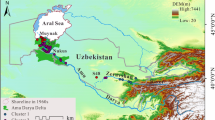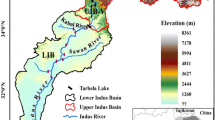Abstract
This research determined potential sources of certain trace elements in the surface waters of the Tabriz area in northwestern Iran. In total, 19 samples from surface waters in the Tabriz area, including the Aji-Chay, Ansa-Rood, Basmenj-Chay, Gomanab-Chay, Mehran-Rood and Sinikh-Chay Rivers, and their branches, were collected in December 2016. Samples were measured/analyzed with respect to electrical conductivity (EC), pH, major (Ca2+, Mg2+, Na+, K+, HCO3−, SO42−, Cl−) and minor (NO3−, F−, SiO2) elements, and certain trace elements (Fe, Mn, Al, Zn, Cd, Pb, Cr, Al and As). The order of abundance for trace elements was Mn > Fe > Al > Zn > Cr > As > Cd > Pb. Cluster analysis divided the samples into two clusters, and the accuracy of the clustering was determined to be 100% by discriminant analysis. The discriminant analysis introduced Cd and Cr as the best parameters to predict sample grouping. Values of EC and concentrations of the major ions and trace elements such as Cd, Pb, Cr and Al, were greater in cluster 2 than in cluster 1. The high EC and its dependent anions (e.g. SO42− and Cl−) in cluster 2 can be considered as one of the driving factors for their release into surface water by forming SO42− and Cl− complexes with metals. The concentrations of SiO2 and As were greater in cluster 1 than in cluster 2 due to the impact of the volcanic formations of Sahand Mountain. Factor analysis identified four factors, which cumulatively explained 80.1% of the variance of the hydrochemistry of the surface water, and which were related to both natural and anthropogenic processes.







Similar content being viewed by others
References
Al-Qudah O, Woocay A, Walton J (2011) Identification of probable groundwater paths in the Amargosa Desert vicinity. Appl Geochem 26:565–570
Asadian A, Eftekhar Nejad J (1993) Geological map of Tabriz sheet (1:100,000). Geological Survey of Iran, Tehran
Asghari Moghaddam A (1991) The hydrogeology of the Tabriz area, Iran. Ph.D. thesis, Department of Geological Sciences, University College London
Asghari Moghaddam A, Allaf Najib M (2006) Hydrogeologic characteristics of the alluvial tuff aquifer of northern Sahand Mountain slopes, Tabriz, Iran. Hydrogeol J 14(7):1319–1329
Barakat A, Baghdadi ME, Rais J, Aghezzaf B, Slassi M (2016) Assessment of spatial and seasonal water quality variation of Oum Er Rbia River (Morocco) using multivariate statistical techniques. Int Soil Water Conserv Res 4(4):284–292
Barzegar R, Asghari Moghadam A, Kazemian N (2015) Assessment of heavy metals concentrations with emphasis on arsenic in the Tabriz plain aquifers, Iran. Environ Earth Sci 74:297–313
Barzegar R, Asghari Moghaddam A, Najib M, Kazemian N, Adamowski J (2016a) Characterization of hydrogeologic properties of the Tabriz plain multi-layer aquifer system, NW Iran. Arab J Geosci 9:147
Barzegar R, Asghari Moghaddam A, Tziritis E (2016b) Assessing the hydrogeochemistry and water quality of the Aji-Chay River, northwest of Iran. Environ Earth Sci 75:1486
Barzegar R, Asghari Moghaddam A, Tziritis E, Fakhri MS, Soltani S (2017a) Identification of hydrogeochemical processes and pollution sources of groundwater resources in the Marand plain, northwest of Iran. Environ Earth Sci 76:297
Barzegar R, Asghari Moghaddam A, Tziritis E (2017b) Hydrogeochemical features of groundwater resources in Tabriz plain, northwest of Iran. Appl Water Sci 7(7):3997–4011
Bilgin A, Konanc MU (2016) Evaluation of surface water quality and heavy metals pollution of Coruh River Basin (Turkey) by multivariate statistical methods. Environ Earth Sci 75:1029
Domenico PA, Schwartz FW (1998) Physical and chemical hydrogeology, 2nd edn. John Wiley and Sons Inc, New York, p 506
Güler C, Thyne GD, McCray JE, Turner KA (2002) Evaluation of graphical and multivariate statistical methods for classification of water chemistry data. Hydrogeol J 10(4):455–474
Hajigholizadeh M, Melesse AM (2017) Assortment and spatiotemporal analysis of surface water quality using cluster and discriminant analyses. CATENA 151:247–258
Halim MA, Majumder RK, Nessa SA, Hiroshiro Y, Uddin MJ, Shimada J, Jinno K (2009) Hydrogeochemistry and arsenic contamination of groundwater in the Ganges Delta Plain, Bangladesh. J Hazard Mater 164:1335–1345
IBM Corp (2012) IBM SPSS statistics for windows, version 21.0. IBM Corp, Armonk
Ismail A, Toriman ME, Juahir H, Zain SM, Habir NLA, Retnam A, Kamaruddin MKA, Umar R, Azid A (2016) Spatial assessment and source identification of heavy metals pollution in surface water using several chemometric techniques. Mar Pollut Bull 106(1):292–300
Kaiser HF (1960) The application of electronic computers to factor analysis. Educ Psychol Meas 20(1):141–151
Kikuchi T, Furuichi T, Hai HT, Tanaka S (2009) Assessment of heavy metal pollution in river water of Hanoi, Vietnam using multivariate analyses. Bull Environ Contam Toxicol 83(4):575–582
Lawrence FW, Upchurch SB (1982) Identification of recharge areas using geochemical factor analysis. Ground Water 20:680–687
Linting M, Meulman JJ, Groenen PJF, Van der Kooij AJ (2007) Non-linear principal components analysis: introduction and application. Psychol Methods 12(3):336–358
McKenna JE (2003) An enhanced cluster analysis program with bootstrap significance testing for ecological community analysis. Environ Model Softw 18(2):205–220
Mustapha A, Aris AZ, Yusoff FM, Zakaria MP, Ramli MF, Abdullah AM, Kura NU, Narany TS (2014) Statistical approach in determining the spatial changes of surface water quality at the upper course of Kano River, Nigeria. Water Qual Expo Health 6:127
Otto M (1998) Multivariate methods. In: Kellner R, Mermet JM, Otto M, Widmer HM (eds) Analytical chemistry. Wiley, Weinheim, p 916
Papatheodorou G, Lambrakis N, Panagopoulos G (2007) Application of multivariate statistical procedures to the hydrochemical study of a coastal aquifer: an example from Crete, Greece. Hydrol Process 21(11):1482–1495
Piper AM (1944) A graphic procedure in the geochemical interpretation of water analyses. Trans Am Geophys Union 25:914–928
Pirmohammadi F, Ameri A, Jahangiri A, Chen CH, Keskin M (2011) Source and tectonic setting of Sahand (south of Tabriz) volcanic rocks using geochemical evidences. Geosciences 21(81):179–190
Rouvier H, Perthuisot V, Mansouri A (1985) Pb–Zn deposits and salt bearing diapirs in southern Europe and north Africa. Econ Geol 80:666–687
Siepak M, Sojka M (2017) Application of multivariate statistical approach to identify trace elements sources in surface waters: a case study of Kowalskie and Stare Miasto reservoirs, Poland. Environ Monit Assess 189:364
Soltani S, Asghari Moghaddam A, Barzegar R, Kazemian N, Tziritis E (2017) Hydrogeochemistry and water quality of the Kordkandi-Duzduzan plain, NW Iran: application of multivariate statistical analysis and PoS index. Environ Monit Assess 189(9):455
Thiemann M, Scheibler E, Wiegand KW (2000) Nitric acid, nitrous acid, and nitrogen oxides. Ullmann’s encyclopedia of industrial chemistry. Wiley-VCH, Weinheim. https://doi.org/10.1002/14356007.a17_293
Tziritis E, Datta PS (2017) Barzegar R (2017) Characterization and assessment of groundwater resources in a complex hydrological basin of central Greece (Kopaida basin) with the Joint use of hydrogeochemical analysis, multivariate statistics and stable isotopes. Aquat Geochem 23:271
Voutsis N, Kelepertzis E, Tziritis E, Keleprtsis A (2015) Assessing the hydrogeochemistry of groundwaters in ophiolite areas of Euboea Island, Greece, using multivariate statistical methods. J Geochem Explor 159:79–92
Ward JH (1963) Hierarchical grouping to optimize an objective function. J Am Stat Assoc 301:236–244
Zhaoyong Z, Abuduwaili J, Fengqing J (2015) Heavy metal contamination, sources, and pollution assessment of surface water in the Tianshan Mountains of China. Environ Monit Assess 187(2):33
Author information
Authors and Affiliations
Corresponding author
Additional information
Publisher's Note
Springer Nature remains neutral with regard to jurisdictional claims in published maps and institutional affiliations.
Rights and permissions
About this article
Cite this article
Barzegar, R., Asghari Moghaddam, A., Soltani, S. et al. Natural and anthropogenic origins of selected trace elements in the surface waters of Tabriz area, Iran. Environ Earth Sci 78, 254 (2019). https://doi.org/10.1007/s12665-019-8250-z
Received:
Accepted:
Published:
DOI: https://doi.org/10.1007/s12665-019-8250-z




